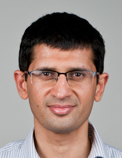 |
 |
| Sricharan Bandhakavi, senior scientist, Bio-Rad Laboratories | Gary Smejkal, research scientist, Covaris |
Innovations Accelerate GeLC-MS and Deliver Reproducible 2-D gels
Hercules, CA — September 5, 2012 — Scientists worldwide will be highlighting how they use Bio-Rad Laboratories’ sample prep technologies to reduce time, increase reliability, and boost confidence in their proteomic workflows at the HUPO 11th Annual World Congress in Boston on Sept. 9–13. Bio-Rad will be at booth 207.
“Robust pre-analytical sample prep technology is essential for getting reproducible downstream results,” said Katy McGirr, a product manager with Bio-Rad’s Lab Separation Division.
Accelerating GeLC-MS
Sricharan Bandhakavi, a senior scientist at Bio-Rad, collaborated with researchers LeeAnn Higgins and Todd Markowski at a proteomics core lab to integrate Bio-Rad’s stain-free gel technology in a modified GeLC-MS protocol. This widely used proteomics workflow involves electrophoretically resolving protein mixtures on an SDS-PAGE gel, staining for visualization, cutting lanes into discrete fractions, processing for in-gel protein digestion, and analyzing purified peptides by LC-MS/MS.
Using the modified GeLC-MS protocol, the researchers gained substantial savings in time without sacrificing the quality of their mass spectrometric results. First, they reduced gel electrophoresis times from ~1 hour (using traditional Tris-HCI gels) to 30 minutes with the faster running Bio-Rad® Criterion™ TGX Stain-Free™ gels. Next, Higgins and Markowski eliminated their usual Coomassie Blue staining/destaining steps by using stain-free technology to visualize protein lanes for cutting into discrete fractions. When imaged using the Gel Doc™ EZ or ChemiDoc™ MP imagers, visualization of proteins can be accomplished in as little as 30 seconds. Both these changes saved the researchers significant time without causing any losses to protein, peptide, or spectral identifications via mass spectrometry.
“It’s great to be able to quickly locate your bands so you can punch them out for further processing — without having to wait for the staining/destaining,” said Markowski.
“Using the stain-free detection method, it’s conceivable that scientists could do in one day what typically takes two days,” added Higgins.
Bandhakavi and collaborators will share their findings in an Industry Advisory Board talk titled “Stain-Free Gels as a Fast and Convenient Sample Prep Tool for 1-D LC/MS-MS,” at 4:15–4:45PM on September 9.
Using the PROTEAN® i12™ IEF Cell to Achieve Reproducible 2-D Gels
A long-held goal in the 2-D electrophoresis (2DE) scientific community is making the results of the technology more reproducible. Covaris (Woburn, Mass.) seeks to standardize proteomics sample preparation for greater reproducibility.
The PROTEAN i12 IEF system played a significant role in streamlining the development of reagents and protocols for Covaris’ new sample preparation device called the t-PREP Biomarker Extraction System, a system for the collection, cryofracture, and extraction of biomarkers from less than 10 mg of tissue. t-PREP uses the company’s Adaptive Focused Acoustics (AFA) technology, which has been shown to generate more consistent and reproducible data than such traditional techniques for disrupting cells and tissues as dounce, mortar and pestle, and other mechanical methods. As part of optimizing new extraction methods for the t-PREP, Gary Smejkal, a Covaris research scientist, tested different sample extraction buffers.
“The conductivities of the samples might be so varied that I would otherwise have to do multiple separate IEF runs,” said Smejkal. “Because of the PROTEAN i12 IEF system’s independently controlled power supplies, I can mix and match different samples and different pH gradients in a single run.”
“It really, really, really enabled us to have an accelerated development process,” added Simon Price, head of sales and marketing at Covaris.
In addition to the convenience and timesavings, the independently powered lanes of the PROTEAN i12 IEF system generate more reproducible results because sample conductivities don’t interfere with each other as they do in typical IEF cells.
Covaris scientists will be presenting a talk and two posters at HUPO on sample preparation workflows using the t-PREP and AFA for phosphorylated proteins, small tissues (important for needle biopsies) and preservation of biomarker activity.
Testing for Inter-Laboratory Reproducibility
German researchers in Cologne, Munich, and Dusseldorf used the PROTEAN i12 IEF system as part of a standardized 2DE workflow to test inter-laboratory reproducibility. Using the same instrument, consumables, sample, and protocol, they found that results between the labs were just as consistent as results within labs, indicating high reproducibility of results can be generated across different laboratories. Their goal is to develop standard operating procedures that will enable even novice researchers to generate reproducible 2DE results.
Thomas Franz will present these results in a poster titled “2-D Gel Electrophoresis Entering the Next Level of Reproducibility: An Inter-Laboratory Comparison.”
About Bio-Rad
Bio-Rad Laboratories, Inc. (NYSE: BIO and BIOb) has remained at the center of scientific discovery for more than 50 years, manufacturing and distributing a broad range of products for the life science research and clinical diagnostic markets. The company is renowned worldwide among hospitals, universities, major research institutions, as well as biotechnology and pharmaceutical companies for its commitment to quality and customer service. Founded in 1952, Bio-Rad is headquartered in Hercules, California, and serves more than 100,000 research and industry customers worldwide through its global network of operations. The company employs over 7,100 people globally and had revenues exceeding $2 billion in 2011. For more information, visit www.bio-rad.com.
This release contains certain forward-looking statements within the meaning of the Private Securities Litigation Reform Act of 1995 and Section 21E of the Securities Exchange Act of 1934. Forward-looking statements generally can be identified by the use of forward-looking terminology such as, “believe,” “expect,” “may,” “will,” “intend,” “estimate,” “continue,” or similar expressions or the negative of those terms or expressions. Such statements involve risks and uncertainties, which could cause actual results to vary materially from those expressed in or indicated by the forward-looking statements. For further information regarding the Company’s risks and uncertainties, please refer to the “Risk Factors” in the Company’s public reports filed with the Securities and Exchange Commission, including the Company’s most recent Annual Report on Form 10-K, Quarterly Reports on Form 10-Q and Current Reports on Form 8-K. The Company cautions you not to place undue reliance on forward-looking statements, which reflect an analysis only and speak only as of the date hereof. Bio-Rad Laboratories, Inc., disclaims any obligation to update these forward-looking statements.
For more information contact:
Katy McGirr
Bio-Rad Laboratories, Inc.
510-741-6548
Katy_McGirr@bio-rad.com
Ken Li
Chempetitive Group
312-997-2436 x 109
kli@chempetitive.com
